Case 2: Inscribing ValueAs literary annuals became increasingly lavish and riddle pages and diaries were removed, it seems that readers became less inclined to annotate them. However, personalized messages written in annuals became an important part of the social value of individual volumes. In his essay "Pocket-Books and Keepsakes" from the Keepsake for 1828, Leigh Hunt explains the value of personalization, arguing that "one precious name, or little inscription at the beginning of the volume, where the hand that wrote it is known to be generous in its wishes, if not in its means, is worth all the binding in St. James's." Publishers even introduced elaborate inscription plates to encourage personalization. In many of the annuals at the University of Toronto, these inscription plates have been left blank, with givers and owners choosing instead to write on the flyleaves of their volumes. Displayed here are a variety of flyleaves and inscription plates that have been personalized. These inscribed books are an important resource, offering clues about how annuals were exchanged, who was buying them, and who might have been reading them.
Item No. 6: Change of Heart? The Literary Souvenir for 1828 did not have an inscription plate; however, this copy has been personalized in pen on the back of the front endpaper. It reads: "A Souvenir of the most important &, I trust, the happiest year of your life." Interestingly, when examined closely, it is evident that the inscription was originally signed, but the signature was subsequently scratched out. |
|
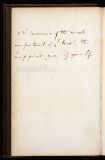 [click image to enlarge] |
|
|
Item No. 7: Prizes Though usually seen as books exchanged between friends, family, and lovers, annuals were also presented as prizes at school. This copy of the 1828 Bijou was awarded for academic dedication. The inscription on the front flyleaf reads: "Miss Anne Brocklehurst Awarded to her for unremitted attention to her studies 1828." |
|
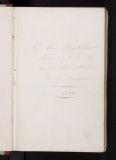 [click image to enlarge] |
|
Item No. 8: Family Introduced in the 1830s, cameo embossed inscription plates, like the one pictured here, exemplify the importance annual publishers placed on incorporating the newest and most eye-catching technological advancements in their volumes. This yellow presentation plate from the 1831 Forget Me Not records a father’s present to his daughter: "M [Dast?]ley the gift of her Papa 1831 London." |
|
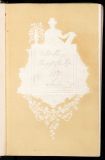 [click image to enlarge] |
|
Item No. 9: Names In the 1834 edition of the Friendship's Offering, the presentation plate doubles as the engraved title page. The detailed design indicates how presentation plates, like other engravings, were often seen as works of art. As such, inscriptions were often kept to a minimum. In this copy it is unclear whether the book has been inscribed to or by its apparent owner, Ellen Viveash. |
|
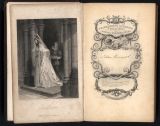 [click image to enlarge] |
|
Items No. 10 and No. 11: Coleridge’s Presentation Copy and Letter Contributors to annuals often received complementary presentation copies of the volumes in which their works appeared. This 1826 copy of The Literary Souvenir belonged to Samuel Taylor Coleridge, who contributed the short poem "The Exchange" to the volume. The inscription on the front flyleaf reads: "Samuel Taylor Coleridge with the respectful regards of his friend Alaric A. Watts. Dec 31, 1826." In a letter dated January 1, 1827, Coleridge acknowledges the receipt of Watt's gift of three volumes of The Literary Souvenir: 1825, 1826, and 1827. In the letter Coleridge explains that though he has not yet read all three volumes, he hopes Watts will "be content to accept my best thanks for the splendid copy of the two last, 1826 -1827—and my daughter's by anticipation." |
|
 [click image to enlarge] |
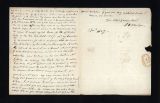 [click image to enlarge] |
| < Previous | Next > |
